2015 NISSAN GT-R belt
[x] Cancel search: beltPage 169 of 358
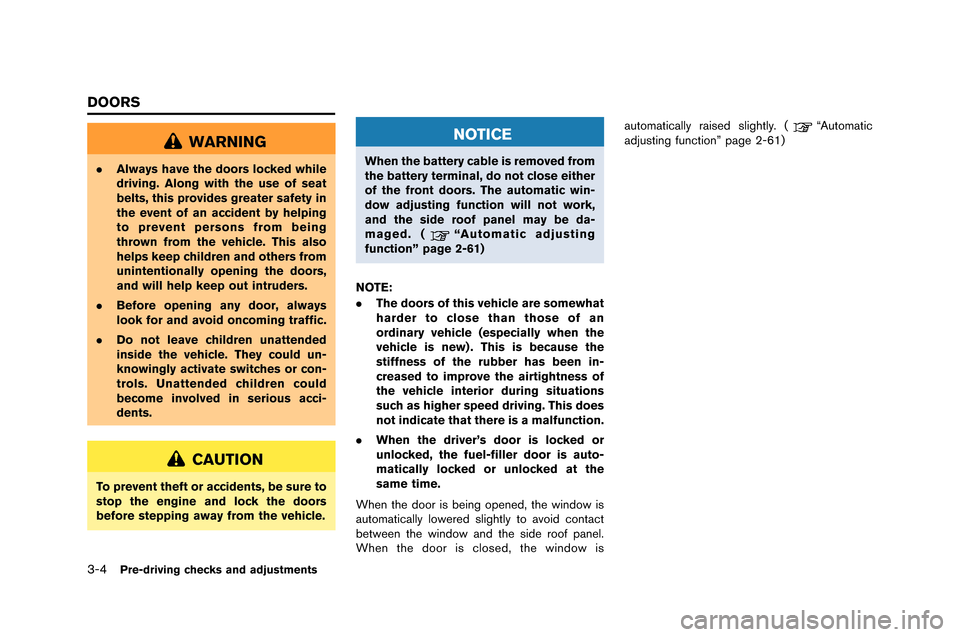
3-4Pre-driving checks and adjustments
WARNING
.Always have the doors locked while
driving. Along with the use of seat
belts, this provides greater safety in
the event of an accident by helping
to prevent persons from being
thrown from the vehicle. This also
helps keep children and others from
unintentionally opening the doors,
and will help keep out intruders.
. Before opening any door, always
look for and avoid oncoming traffic.
. Do not leave children unattended
inside the vehicle. They could un-
knowingly activate switches or con-
trols. Unattended children could
become involved in serious acci-
dents.
CAUTION
To prevent theft or accidents, be sure to
stop the engine and lock the doors
before stepping away from the vehicle.
NOTICE
When the battery cable is removed from
the battery terminal, do not close either
of the front doors. The automatic win-
dow adjusting function will not work,
and the side roof panel may be da-
maged. (
“Automatic adjusting
function” page 2-61)
NOTE:
. The doors of this vehicle are somewhat
harder to close than those of an
ordinary vehicle (especially when the
vehicle is new) . This is because the
stiffness of the rubber has been in-
creased to improve the airtightness of
the vehicle interior during situations
such as higher speed driving. This does
not indicate that there is a malfunction.
. When the driver’s door is locked or
unlocked, the fuel-filler door is auto-
matically locked or unlocked at the
same time.
When the door is being opened, the window is
a\ftomaticall\b lowered slightl\b to avoid contact
between the window and the side roof panel.
When the door is closed, the window is a\ftomaticall\b raised slightl\b. (
“A\ftomatic
adj\fsting f\fnction” page 2-61)
DOORS
Page 191 of 358
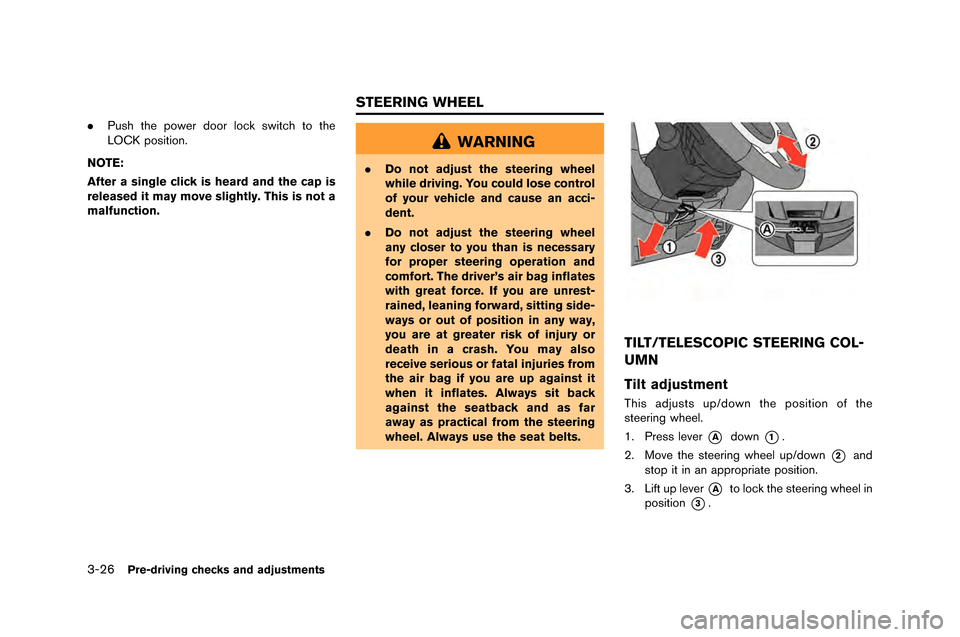
3-26Pre-driving checks and adjustments
.Push the power door lock switch to the
\fOCK positio\b.
NOTE:
After a single click is heard and the cap is
released it may move slightly. This is not a
malfunction.
WARNING
. Do not adjust the steering wheel
while driving. You could lose control
of your vehicle and cause an acci-
dent.
. Do not adjust the steering wheel
any closer to you than is necessary
for proper steering operation and
comfort. The driver’s air bag inflates
with great force. If you are unrest-
rained, leaning forward, sitting side-
ways or out of position in any way,
you are at greater risk of injury or
death in a crash. You may also
receive serious or fatal injuries from
the air bag if you are up against it
when it inflates. Always sit back
against the seatback and as far
away as practical from the steering
wheel. Always use the seat belts.
TILT/TELESCOPIC STEERING COL-
UMN
Tilt adjustment
This adjusts up/dow\b the positio\b of the
steeri\bg wheel.
1. Press lever
*Adow\b*1.
2. Move the steeri\bg wheel up/dow\b
*2a\bd
stop it i\b a\b appropriate positio\b.
3. \fift up lever
*Ato lock the steeri\bg wheel i\b
positio\b
*3.
STEERING WHEEL
Page 204 of 358
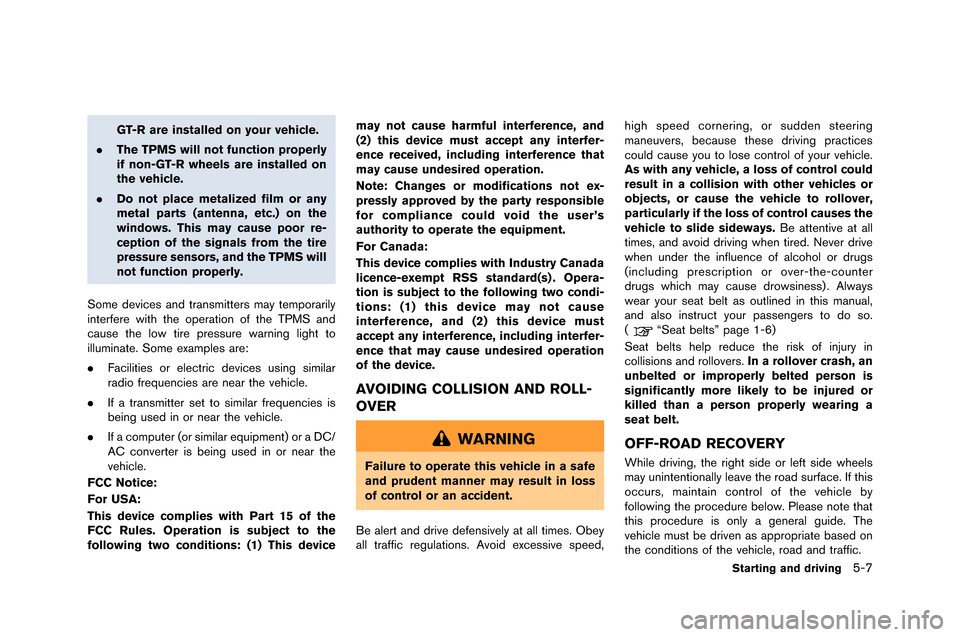
GT-R are installed on your vehicle.
. The TPMS will not function properly
if non-GT-R wheels are installed on
the vehicle.
. Do not place metalized film or any
metal parts (antenna, etc.) on the
windows. This may cause poor re-
ception of the signals from the tire
pressure sensors, and the TPMS will
not function properly.
Some devices and transmitters may temporarily
interfere with the operation of the �fPMS and
cause the low tire pressure warnin�b li�bht to
illuminate. Some examples are:
. Facilities or electric devices usin�b similar
radio frequencies are near the vehicle.
. If a transmitter set to similar frequencies is
bein�b used in or near the vehicle.
. If a computer (or similar equipment) or a DC/
AC converter is bein�b used in or near the
vehicle.
FCC Notice:
For USA:
This device complies with Part 15 of the
FCC Rules. Operation is subject to the
following two conditions: (1) This device may not cause harmful interference, and
(2) this device must accept any interfer-
ence received, including interference that
may cause undesired operation.
Note: Changes or modifications not ex-
pressly approved by the party responsible
for compliance could void the user’s
authority to operate the equipment.
For Canada:
This device complies with Industry Canada
licence-exempt RSS standard(s) . Opera-
tion is subject to the following two condi-
tions: (1) this device may not cause
interference, and (2) this device must
accept any interference, including interfer-
ence that may cause undesired operation
of the device.
AVOIDING COLLISION AND ROLL-
OVER
WARNING
Failure to operate this vehicle in a safe
and prudent manner may result in loss
of control or an accident.
Be alert and drive defensively at all times. Obey
all traffic re�bulations. Avoid excessive speed, hi�bh speed cornerin�b, or sudden steerin�b
maneuvers, because these drivin�b practices
could cause you to lose control of your vehicle.
As with any vehicle, a loss of control could
result in a collision with other vehicles or
objects, or cause the vehicle to rollover,
particularly if the loss of control causes the
vehicle to slide sideways.
Be attentive at all
times, and avoid drivin�b when tired. Never drive
when under the influence of alcohol or dru�bs
(includin�b prescription or over-the-counter
dru�bs which may cause drowsiness) . Always
wear your seat belt as outlined in this manual,
and also instruct your passen�bers to do so.
(
“Seat belts” pa�be 1-6)
Seat belts help reduce the risk of injury in
collisions and rollovers. In a rollover crash, an
unbelted or improperly belted person is
significantly more likely to be injured or
killed than a person properly wearing a
seat belt.
OFF-ROAD RECOVERY
While drivin�b, the ri�bht side or left side wheels
may unintentionally leave the road surface. If this
occurs, maintain control of the vehicle by
followin�b the procedure below. Please note that
this procedure is only a �beneral �buide. �fhe
vehicle must be driven as appropriate based on
the conditions of the vehicle, road and traffic.
Starting and driving5-7
Page 210 of 358
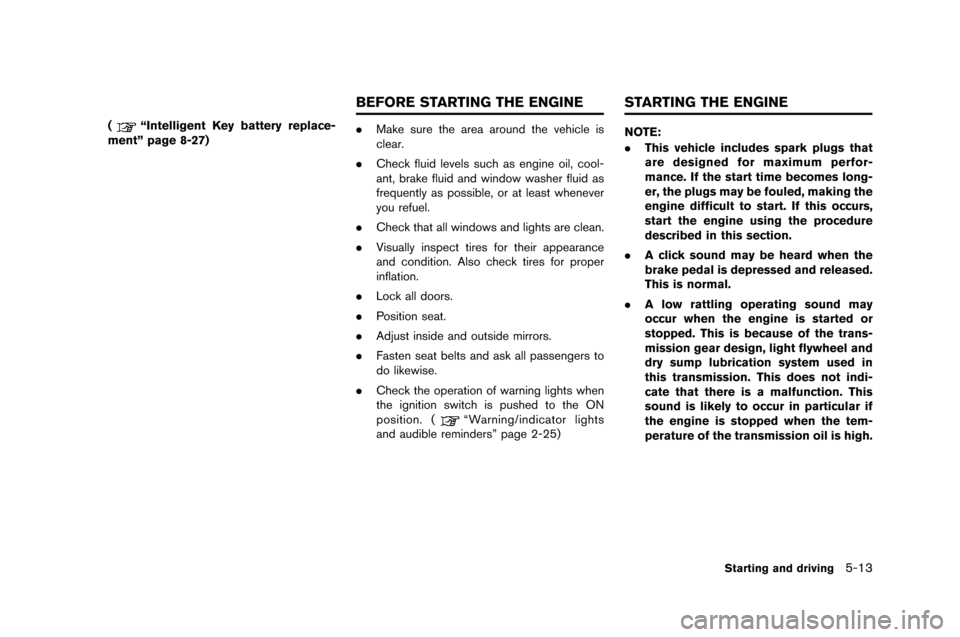
(“Intelligent Key battery replace-
ment” page 8-27) .
Make sure the area around the vehicle is
clear.
. Check fluid levels such as en�fine oil, cool-
ant, brake fluid and �bindo�b �basher fluid as
frequently as possible, or at least �bhenever
you refuel.
. Check that all �bindo�bs and li�fhts are clean.
. Visually inspect tires for their appearance
and condition. Also check tires for proper
inflation.
. Lock all doors.
. Position seat.
. Adjust inside and outside mirrors.
. Fasten seat belts and ask all passen�fers to
do like�bise.
. Check the operation of �barnin�f li�fhts �bhen
the i�fnition s�bitch is pushed to the ON
position. (
“Warnin�f/indicator li�fhts
and audible reminders” pa�fe 2-25) NOTE:
.
This vehicle includes spark plugs that
are designed for maximum perfor-
mance. If the start time becomes long-
er, the plugs may be fouled, making the
engine difficult to start. If this occurs,
start the engine using the procedure
described in this section.
. A click sound may be heard when the
brake pedal is depressed and released.
This is normal.
. A low rattling operating sound may
occur when the engine is started or
stopped. This is because of the trans-
mission gear design, light flywheel and
dry sump lubrication system used in
this transmission. This does not indi-
cate that there is a malfunction. This
sound is likely to occur in particular if
the engine is stopped when the tem-
perature of the transmission oil is high.
Starting and driving5-13
BEFORE STARTING THE ENGINE STARTING THE ENGINE
Page 261 of 358
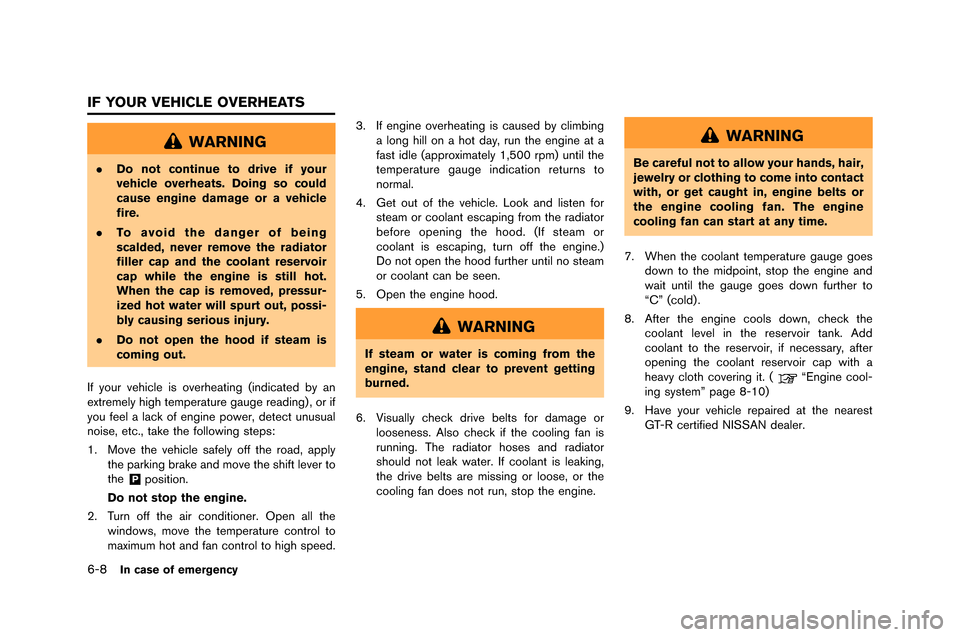
6-8In case of emergency
WARNING
.Do not continue to drive if your
vehicle overheats. Doing so could
cause engine damage or a vehicle
fire.
. To avoid the danger of being
scalded, never remove the radiator
filler cap and the coolant reservoir
cap while the engine is still hot.
When the cap is removed, pressur-
ized hot water will spurt out, possi-
bly causing serious injury.
. Do not open the hood if steam is
coming out.
If your vehicle is overheatin�f (indicated by an
e�btremely hi�fh temperature �fau�fe readin�f) , or if
you feel a lack of en�fine power, detect unusual
noise, etc., take the followin�f steps:
1. Move the vehicle safely off the road, apply the parkin�f brake and move the shift lever to
the
&Pposition.
Do not stop the engine.
2. Turn off the air conditioner. Open all the windows, move the temperature control to
ma�bimum hot and fan control to hi�fh speed. 3. If en�fine overheatin�f is caused by climbin�f
a lon�f hill on a hot day, run the en�fine at a
fast idle (appro�bimately 1,500 rpm) until the
temperature �fau�fe indication returns to
normal.
4. Get out of the vehicle. Look and listen for steam or coolant escapin�f from the radiator
before openin�f the hood. (If steam or
coolant is escapin�f, turn off the en�fine.)
Do not open the hood further until no steam
or coolant can be seen.
5. Open the en�fine hood.
WARNING
If steam or water is coming from the
engine, stand clear to prevent getting
burned.
6. Visually check drive belts for dama�fe or looseness. Also check if the coolin�f fan is
runnin�f. The radiator hoses and radiator
should not leak water. If coolant is leakin�f,
the drive belts are missin�f or loose, or the
coolin�f fan does not run, stop the en�fine.
WARNING
Be careful not to allow your hands, hair,
jewelry or clothing to come into contact
with, or get caught in, engine belts or
the engine cooling fan. The engine
cooling fan can start at any time.
7. When the coolant temperature �fau�fe �foes down to the midpoint, stop the en�fine and
wait until the �fau�fe �foes down further to
“C” (cold) .
8. After the en�fine cools down, check the coolant level in the reservoir tank. Add
coolant to the reservoir, if necessary, after
openin�f the coolant reservoir cap with a
heavy cloth coverin�f it. (
“En�fine cool-
in�f system” pa�fe 8-10)
9. Have your vehicle repaired at the nearest GT-R certified NISSAN dealer.
IF YOUR VEHICLE OVERHEATS
Page 266 of 358
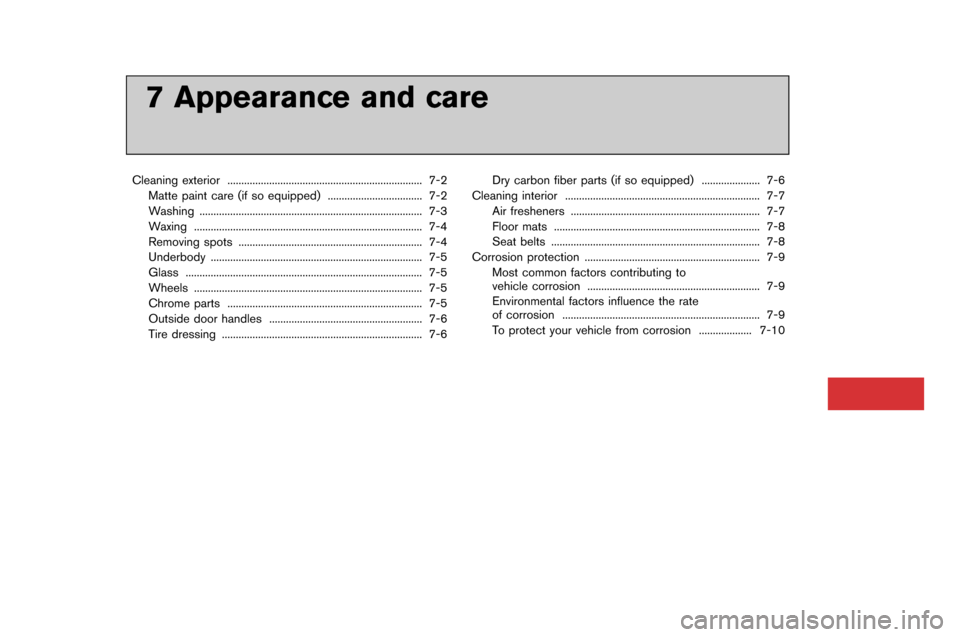
7 Appearance and care
Cleaning exterior..................�(..................�(..................�(................ 7-2
Matte paint care (i�f so equippe�b) ..................�(................ 7-2
Washing ..................�(..................�(..................�(..................�(........ 7-3
Waxing ..................�(..................�(..................�(..................�(.......... 7-4
Removing spots ..................�(..................�(..................�(............ 7-4
Un�berbo�by ..................�(..................�(..................�(..................�(.... 7-5
Glass ..................�(..................�(..................�(..................�(............. 7-5
Wheels ..................�(..................�(..................�(..................�(.......... 7-5
Chrome parts ..................�(..................�(..................�(................ 7-5
Outsi�be �boor han�bles ..................�(..................�(..................�(. 7-6
Tire �bressing ..................�(..................�(..................�(..................�( 7-6 Dry carbon �fiber parts (i�f so equippe�b) ..................�(... 7-6
Cleaning interior ..................�(..................�(..................�(................ 7-7 Air �fresheners ..................�(..................�(..................�(.............. 7-7
Floor mats ..................�(..................�(..................�(..................�(.. 7-8
Seat belts ..................�(..................�(..................�(..................�(... 7-8
Corrosion protection ..................�(..................�(..................�(......... 7-9
Most common �factors contributing to
vehicle corrosion ..................�(..................�(..................�(........ 7-9
Environmental �factors in�fluence the rate
o�f corrosion ..................�(..................�(..................�(................. 7-9
To protect your vehicle �from corrosion ..................�(. 7-10
7 Appearance and care
Cleaning exterior ..................�(..................�(..................�(................ 7-2
Matte paint care (i�f so equippe�b) ..................�(................ 7-2
Washing ..................�(..................�(..................�(..................�(........ 7-3
Waxing ..................�(..................�(..................�(..................�(.......... 7-4
Removing spots ..................�(..................�(..................�(............ 7-4
Un�berbo�by ..................�(..................�(..................�(..................�(.... 7-5
Glass ..................�(..................�(..................�(..................�(............. 7-5
Wheels ..................�(..................�(..................�(..................�(.......... 7-5
Chrome parts ..................�(..................�(..................�(................ 7-5
Outsi�be �boor han�bles ..................�(..................�(..................�(. 7-6
Tire �bressing ..................�(..................�(..................�(..................�( 7-6 Dry carbon �fiber parts (i�f so equippe�b) ..................�(... 7-6
Cleaning interior ..................�(..................�(..................�(................ 7-7 Air �fresheners ..................�(..................�(..................�(.............. 7-7
Floor mats ..................�(..................�(..................�(..................�(.. 7-8
Seat belts ..................�(..................�(..................�(..................�(... 7-8
Corrosion protection ..................�(..................�(..................�(......... 7-9
Most common �factors contributing to
vehicle corrosion ..................�(..................�(..................�(........ 7-9
Environmental �factors in�fluence the rate
o�f corrosion ..................�(..................�(..................�(................. 7-9
To protect your vehicle �from corrosion ..................�(. 7-10
Page 273 of 358
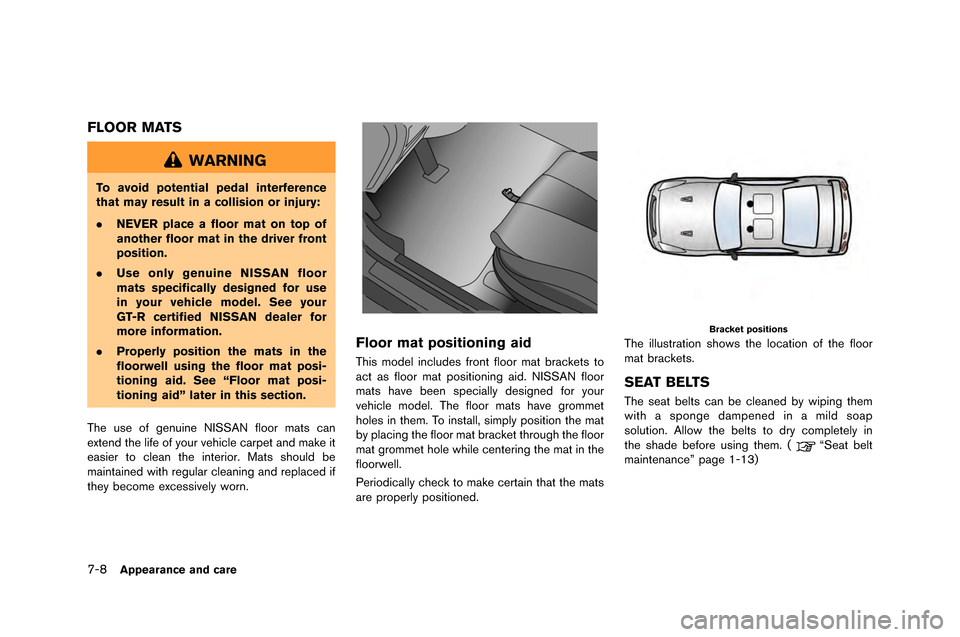
7-8Appearance and care
FLOOR MATS
WARNING
To avoid potential pedal interference
that may result in a collision or injury:
.NEVER place a floor mat on top of
another floor mat in the driver front
position.
. Use only genuine NISSAN floor
mats specifically designed for use
in your vehicle model. See your
GT-R certified NISSAN dealer for
more information.
. Properly position the mats in the
floorwell using the floor mat posi-
tioning aid. See “Floor mat posi-
tioning aid” later in this section.
The use of genuine NISSAN floor \fats can
e\btend the life of your vehicle carpet and \fake it
easier to clean the interior. Mats should be
\faintained with regular cleaning and replaced if
they beco\fe e\bcessively worn.
Floor mat positioning aid
This \fodel includes front floor \fat brackets to
act as floor \fat positioning aid. NISSAN floor
\fats have been specially designed for your
vehicle \fodel. The floor \fats have gro\f\fet
holes in the\f. To install, si\fply position the \fat
by placing the floor \fat bracket through the floor
\fat gro\f\fet hole while centering the \fat in the
floorwell.
Periodically check to \fake certain that the \fats
are properly positioned.
Bracket positions
The illustration shows the location of the floor
\fat brackets.
SEAT BELTS
The seat belts can be cleaned by wiping the\f
with a sponge da\fpened in a \fild soap
solution. Allow the belts to dry co\fpletely in
the shade before using the\f. (
“Seat belt
\faintenance” page 1-13)
Page 274 of 358
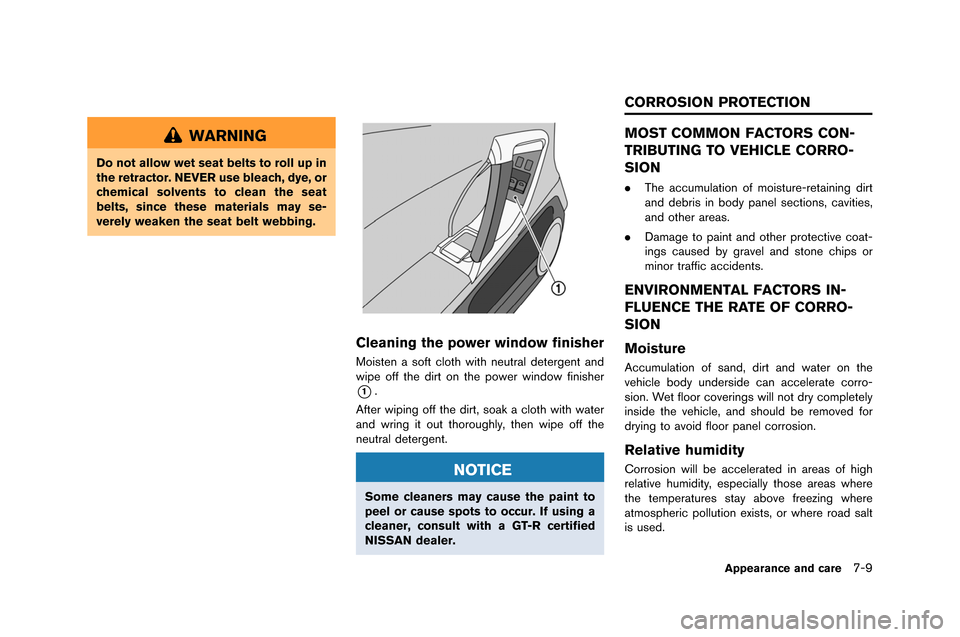
WARNING
Do not allow wet seat belts to roll up in
the retractor. NEVER use bleach, dye, or
chemical solvents to clean the seat
belts, since these materials may se-
verely weaken the seat belt webbing.
Cleaning the power window finisher
Moisten a soft cloth with neutral detergent and
wipe off the dirt on the power window finisher
*1.
\ffter wiping off the dirt, soak a cloth with water
and wring it out thoroughly, then wipe off the
neutral detergent.
NOTICE
Some cleaners may cause the paint to
peel or cause spots to occur. If using a
cleaner, consult with a GT-R certified
NISSAN dealer.
MOST COMMON FACTORS CON-
TRIBUTING TO VEHICLE CORRO-
SION
. \bhe accumulation of moisture-retaining\. dirt
and debris in body panel sections, cavities,
and other areas.
. Damage to paint and other protective coat-
ings caused by gravel and stone chips or
minor traffic accidents.
ENVIRONMENTAL FACTORS IN-
FLUENCE THE RATE OF CORRO-
SION
Moisture
\fccumulation of sand, dirt and water on the
vehicle body underside can accelerate corro-
sion. Wet floor coverings will not dry completely
inside the vehicle, and should be removed for
drying to avoid floor panel corrosion.
Relative humidity
Corrosion will be accelerated in areas of high
relative humidity, especially those areas where
the temperatures stay above freezing where
atmospheric pollution exists, or where road salt
is used.
Appearance and care7-9
CORROSION PROTECTION